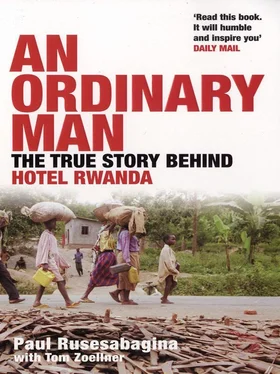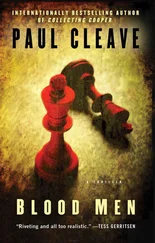It saddens me to tell you that one of the archetypical images of my country became the Tutsi king borne on the shoulders of a platoon of Hutu laborers. It is true that my country, just as every civilization on earth, has economic and social inequalities in our past. What makes Rwanda particularly tragic, however, is that our unhappiness was given its shape by the indelible contours of race, making it all the easier for the great-grandsons of the whipped to find someone’s head to chop off.
Rwanda ’s apartheid system began to fall apart in the 1950s, when it was becoming increasingly clear that the European powers could no longer hold on to their colonies in Africa. Independence movements were sweeping the continent-violently in some places, such as Kenya, Algeria, and the Belgian Congo. Nearly every nation that had participated in the Berlin Conference had been shell-shocked by World War II and no longer had a taste for empire. Under pressure from the United Nations and the world community, Belgium was getting ready to let go of its claim on Rwanda. But one last surprise was in store.
The Tutsi aristocracy had, not surprisingly, been generally supportive of their Belgian patrons through the years. But it was a devil’s bargain. The Tutsis received a limited amount of power and a condescending recognition of the mwami in exchange for their ultimate loyality to Brussels. They also cooperated in the oppression of the Hutu, who were forced to harvest timber and crops in crews of road gangs, with Tutsi bosses. As any social scientist can tell you, any system of organized hatred also damages the oppressor, if in less obvious ways. Tutsi were forced to punish their Hutu neighbors for misdeeds or face punishment themselves. And Belgium left no doubt who was in charge in 1931 when they deposed the mwami Musinga, who had resisted all the arguments of all the Catholic priests sent from Europe to convert the natives. The colonizers ignored the squash seeds and handpicked a successor, King Rudahigwa, a man considered sufficiently pliable. He was also an ardent Roman Catholic. His example led Tutsis and Hutus alike to convert to the new faith. Almost overnight Rwanda became one of the most Christian nations on the globe, albeit with a strong flavor of the old mysticism. The Catholic priests from Europe, however, helped foment a revolutionary twist in the history of Rwanda.
A well of sympathy for the Hutu underclass had been building throughout the late 1950s. The key role was played by the Roman Catholic Church. Perhaps it was the words of Jesus’ Sermon on the Mount: “Blessed are the poor in spirit for theirs is the kingdom of heaven… blessed are the meek, for they will inherit the earth.” Or perhaps it was that Belgium itself is a nation of competing ethnicities and that many of the Catholic priests sent to Rwanda were from the historically abused Flemish communities. Perhaps there was finally a sense that too much was too much. Either way, the authorities took steps to empower the people who had been suffering for so long. The Hutus had always had superior numbers, and official policy began to reflect that mathematical reality-and then some. The Hutu slowly assumed power as the ruling class. One administrator in Kigali issued the following secret order: “I deem it necessary to rapidly put into place a local military force officially composed of 14 percent Tutsi and 86 percent Hutu but in effect and for practical purposes, 100 percent Hutu.” Fearful of losing their longstanding grip on power-and perhaps also fearful of retributive violence-the Tutsi commenced a period of sharp opposition to Belgium ’s continuing hold on Rwanda. This course would prove disastrous for them, as it finalized the shift in Belgium ’s favor over to the Hutu they had mistreated for sixty years.
On July 27, 1959, our king died of a cerebral hemorrhage, and speculation ran wild that he had been secretly assassinated by the Belgians. His successor, the teenage ruler Kigeli V, would last only a few months before the ancient dynastic line would be snuffed out forever. Belgium called for the first free elections in Rwanda ’s history, but soon found itself trying to put down a rebellion of Hutu insurgents, who had set about murdering Tutsis and setting fire to their houses. Despite the centuries of coexistence, this marked the very first outbreak of systematic ethnic murders in Rwanda. The killers were rewarded with some of the first prosperity they had ever tasted. The homes, fields, and stores of the Tutsis often went into the hands of those who had hacked them apart, establishing a link between patriotism and money that has yet to disappear. I’ll never forget sleeping outside at night during that time, wondering if somebody was going to burn our house down for harboring Tutsis.
The national elections were held in a climate of fear and-not surprisingly-the Hutus won 90 percent of the open seats. Suddenly it became desirable, even necessary, to have an identity card that called you a Hutu. Public schools were soon open to the majority, and children who had been denied education for years began learning to read and write and add figures just as adeptly as the Tutsi. This should have given the lie once and for all to Speke’s idiotic racial ideas-as if they had not been discredited already. Belgium and the United Nations handed the nation over to a Hutu government and left the nation after a brief ceremony on July 1, 1962, at 10 o’clock in the morning. A new flag was hastily designed and raised: a tricolor banner with a plain letter R in the middle. These events, taken as a whole, came to be called the “Hutu Revolution.”And there was to be no sharing of power.
Tens of thousands of persecuted Tutsis fled the country to the safety of Uganda and other neighboring nations. One of the refugees was a small child named Paul Kagame, who was said to have been carried on his mother’s back.
Rwanda had not seen the last of him.

The exiled Tutsis would eventually number more than a quarter million. The angriest young men among them began launching guerrilla raids into Rwanda from their hiding places across the border. They were called “cockroaches” because they came out at night and were hard to kill. This military slang would soon be applied to the Tutsi people as a whole, a term as pernicious and dehumanizing as the American word nigger.
The raids were mostly amateur affairs, but they gave a pretext for our new government of President Grégoire Kayibanda to wrap itself in the flag of the Hutu Revolution and begin a purge of the Tutsis who remained inside Rwanda. There is no greater gift to an insecure leader that quite matches a vague “enemy” who can be used to whip up fear and hatred among the population. It is a cheap way to consolidate one’s hold on power. And this is just what the new regime did.
The persecution was made all the eaiser because Rwanda is a meticulously organized country. The nation is arranged into a series of twelve prefectures, which look a bit like American states, except they have no powers. Within every prefecture are several communes, which are the real building blocks of authority in Rwanda. The head of the commune is known as the bourgmeister, or mayor, and he usually gets his job through a personal friendship with the president. This is the real seat of power in tiny Rwanda, which is like one giant village. Four out of five of us live in the rural areas and nine out of every ten people here draws some income from farming the hills. Even the most urbanized among us has a close connection with the backcountry. And so the orders came down to every hill: It was the duty of every good and patriotic Hutu to join “public safety committees” to periodically help “clear the brush.” Everyone understood this to mean slaughtering Tutsi peasants whenever there was a raid from the exiles across the border. In 1963 thousands of Tutsis were chopped apart in the southern prefecture of Gikongoro. These countryside massacres continued off and on throughout the decade and flared up again after the trouble in Burundi in 1972 that caused the education of my best friend, Gerard, to be stolen.
Читать дальше












![Paul Finch - A Wanted Man [A PC Heckenburg Short Story]](/books/702381/paul-finch-a-wanted-man-a-pc-heckenburg-short-sto-thumb.webp)
